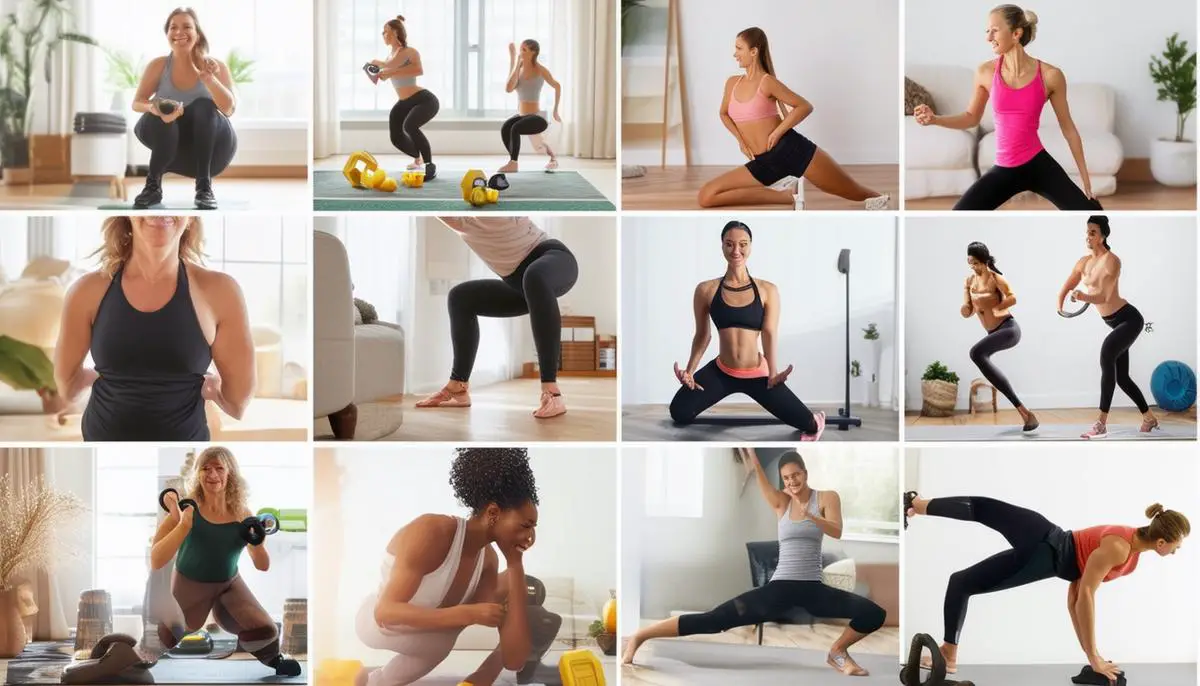HIIT Workouts at Home
HIIT, or High-Intensity Interval Training, is an efficient way to shed weight right from your living room. HIIT workouts mix short bursts of intense exercise with periods of rest or lower-intensity exercise, boosting your metabolism and helping your body burn calories even after you've finished your workout.
To get started, consider the Tabata technique, a form of HIIT that includes 20 seconds of hard work followed by 10 seconds of rest, repeated for a total of four minutes. Simple exercises like high knees or rapid jumping jacks are perfect for this.
Another option is a living room circuit:
- 30 seconds of burpees
- 30 seconds of mountain climbers
- 30 seconds of squat jumps
Remember to breathe during the 30-second rest periods between each set.
For those short on time, a 15-minute HIIT workout can be broken down into three 5-minute chunks — push hard for 20 seconds, then rest or lightly jog for 40 seconds. Include dynamic moves like plank jacks or skater hops to keep things interesting.
HIIT is less about having weights and more about building strength and endurance through speed, power, and effort. If you have lower energy some days, simply scale back the intensity or duration of your workout. Aim to incorporate HIIT into your weekly routine a few times, stay hydrated, and wrap up each session with stretches to keep your muscles flexible.
Turn your hallway into a sprint lane or your stairs into an aerobic stepper. With HIIT, your personal spaces can transform into effective gyms. Track your progress week by week and celebrate your achievements along the way.
Strength Training Without Weights
You don't need weight machines or heavy dumbbells to build muscle at home. Bodyweight exercises and household items can be incredibly effective for strength training.
The classic push-up is a full-body exercise that only requires you and gravity. Beginners can start against a wall to build strength gradually, while more advanced exercisers can try elevating their feet on a sturdy chair for a greater challenge.
Water jugs and packed backpacks can replace dumbbells for exercises like goblet squats. Hold the item chest-high with both hands and drop into a squat to strengthen your quads, hamstrings, glutes, and core.
For a more engaging workout, create an obstacle course using household items. Zigzag through chair legs for agility drills or use heavy books for bicep curls and overhead tricep extensions.
Proper form is crucial to avoid injury. When using a backpack for squats, keep your spine neutral and knees behind your toes. Regularly check that all items are secure to prevent accidents.
Aim to incorporate strength training three to four times a week, gradually increasing resistance and complexity.1 Involve family members to make it a fun, shared experience.
With a little creativity, you can transform everyday items into effective workout tools. Celebrate every pound lifted, whether metal or not, and stay consistent in your efforts to build strength at home.
Integrating Dance and Yoga
Combining dance and yoga in your home workouts is a fantastic way to diversify your fitness routine, burn calories, improve flexibility, and nurture your well-being. Dance provides an exhilarating cardiovascular workout, while yoga offers a grounding and restorative practice.
A 30-minute dance session can burn hundreds of calories, boost cardiovascular health, and bring joy to your fitness journey.2 Clear some space in your living room and let the music guide your movements.
Transitioning from the dynamic energy of dance to the calming poses of yoga allows for a well-rounded workout. Yoga postures encourage body awareness, deep breathing, and stretching, which can improve tone, balance, and circulation, all contributing to weight loss and overall health.
Start your routine with an invigorating dance session to raise your heart rate and release toxins through sweat. As you wind down, flow into yoga poses like warrior or child's pose to cultivate strength, endurance, and inner peace.
Incorporating dance and yoga into your regimen also provides an outlet for stress relief. Dance allows for emotional expression through movement, while yoga promotes introspection and relaxation. Regular practice can help reduce cortisol levels, supporting your weight loss efforts.
Aim to create a balanced weekly schedule with energetic dance workouts and restorative yoga sessions. Consider dedicating three days to dance and two days to yoga. Invite friends and family to join you virtually, fostering connection and shared wellness.
By uniting the vibrancy of dance with the tranquility of yoga, you create a comprehensive fitness routine that supports cardiovascular health, strength, flexibility, and mental well-being. Embrace this harmonious blend in your fitness journey and watch it transform into a sustainable and enjoyable lifestyle change.
Combining various forms of exercise like HIIT, strength training with everyday objects, dance, and yoga keeps your home workouts engaging and effective. By targeting different aspects of fitness and incorporating fun and variety, you'll be more likely to stick with your routine and enjoy the journey towards better health.
Unlock the power of AI with Writio – your go-to content writer! This article was crafted by Writio.
- American College of Sports Medicine. Resistance training for health and fitness. ACSM Current Comment. 2013.
- Ainsworth BE, Haskell WL, Herrmann SD, et al. 2011 Compendium of Physical Activities: a second update of codes and MET values. Medicine and Science in Sports and Exercise. 2011;43(8):1575-1581.
Thank you for reading this post, don't forget to subscribe to our free newsletter
!
